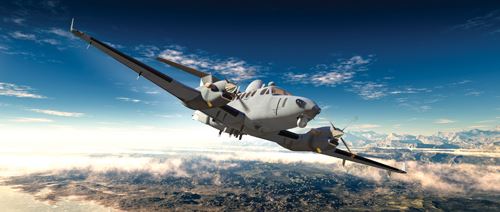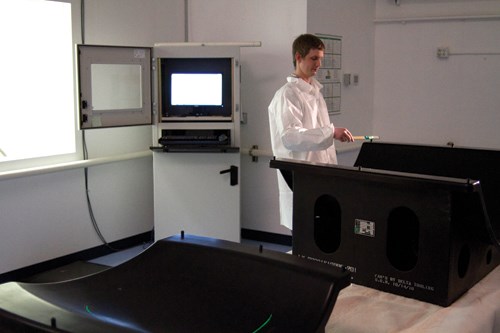Cutting and laser layup technology supports tier fabricator in Boeing project
Prototype production for The Boeing Co.’s (Chicago. Ill.) Enhanced Medium Altitude Reconnaissance and Surveillance System (EMARSS) aircraft gets a boost from cutting and templating hardware/software supplied by Gerber Technology (Tolland, Conn.)
The Boeing Co.’s (Chicago. Ill.) Enhanced Medium Altitude Reconnaissance and Surveillance System (EMARSS) aircraft (see artist’s rendering, first image) is designed to gather intelligence for the U.S. Army. It will provide a persistent capability to detect, locate, classify and identify targets, such as enemy positions, with a high degree of accuracy, 24/7. To streamline the project and reduce risk during the certification process, the aircraft will be built around the already Federal Aviation Admin.-certified Hawker Beechcraft (Wichita, Kan.) King Air 350ER turboprop. An initial prototype flew on Oct. 22, 2012.
Unitech Composites & Structures (Hayden, Idaho), part of the AGC Aerospace & Defense – Composites & Aerostructures Group (Midwest City, Okla.), manufactures the aircraft’s lightweight composite nose skin panels and multiple exterior fairings that enclose and provide transmissivity for radar equipment. Unitech was able to meet the project’s tight tolerances with the help of a GERBERcutter GTxL computer-controlled cutting system, which it used to cut and kit the Cytec Engineered Materials Inc. (Tempe, Ariz.) prepregs, and a Virtek LaserEdge laser templating system, both supplied by Gerber Technology (Tolland, Conn.). “This new program called for 26 parts each for five aircraft, so in addition to precision we needed repeatability of the process,” says Al Haase, president and CEO of AGC. “By eliminating the use of physical templates, layup productivity was improved by as much as 50 percent.”
Two Virtek LaserEdge projection units were installed on the ceiling to provide adequate coverage for the many sizes and angles of the parts. Gerber sent a trainer to Unitech to teach the engineers how to use the equipment, and they, in turn, trained other shop floor employees, says Josiah Drewien, engineering manager for Unitech Composites.
“Before we implemented this technology, employees cut every prepreg ply by hand with scissors using templates, which took considerable time and led to a great deal of waste.” With Gerber’s nesting software, the waste reportedly has dropped to 10 percent, saving money and time, adds Drewien. Additionally, the Virtek LaserEdge projection system enables Unitech to lay up more complex parts.
“For some complex parts, with complicated geometries requiring dozens of partial plies located with greater precision, using a template would be impractical or impossible,” says Drewien. The enhanced technical capabilities provided by the Gerber and Virtek systems not only meet the growing needs of the customer, but also help the company remain price competitive, says Haase.
Related Content
-
TenCate Advanced Armour renamed to Integris Composites
With its rebranding, Integris maintains the ability to develop, test and manufacture ballistic armor and survivability solutions while expanding into new markets where composite solutions can be advantageous.
-
2022 Farnborough International Air Show highlights
Farnborough, as usual, provided a platform for a variety of announcements in the aerospace, defense and advanced air mobility spaces from companies like GKN Aerospace, Joby, Airbus, Rolls-Royce, Boom Supersonic and others.
-
Plant tour: National Institute for Aviation Research, Wichita, Kan., U.S.
NIAR, located at Wichita State University in the heart of the American aerospace manufacturing industry, has evolved to become a premier hub of teaching, R&D, creativity and innovation.
















.jpg;maxWidth=300;quality=90)

